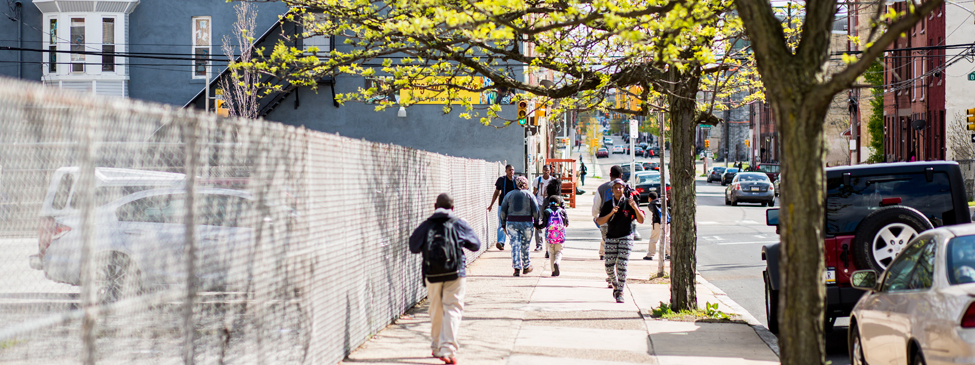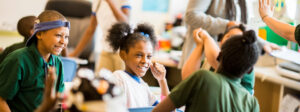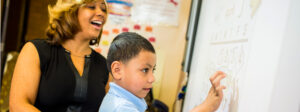Luis Avila is a Senior Vice President at 270 Strategies. In the past, Luis served as a program director at Stand for Children, a nonprofit where he worked with immigrant parents to mobilize thousands of voters to protect funding for their children's schools. In addition to his work as a field organizer, Luis is also a writer, director, and actor in both theater and film. (Full disclosure: He serves on the board of TNTP.) We sat down with Luis to learn more about how he uses his advocacy background to help schools and districts rethink their approach to community engagement.
A lot of your work revolves around advocacy and community organizing. How do you bring those together to help reimagine the work schools and districts could be doing to engage families and communities?
Community organizing is relationship building. Too often organizations think of people as props or tools to accomplish something—it's not real partnership. Through my work, I help organizations think about how we intentionally and genuinely build relationships with people, which at the end of the day, is organizing. The second step is raising the consciousness of people.
I'll give you a concrete example. Many schools teach families that when they donate money to school, it's tax‑deductible. A lot of times we explain, “You can get a tax refund.” But in those conversations, the school usually doesn’t make an effort to teach families how the school is funded. Why does the school have to ask for additional money from families? The reality is every state has a different funding formula, and in the majority of states there's a serious equity issue—particularly in low‑income communities.
Schools would benefit from families knowing how the money is spent. That is what I'm talking about—raising consciousness. By sharing that information the family understands their role in helping the school succeed.
How do you think community organizations and social justice organizations can think more collaboratively about how they're working to support education?
Organizations can do a better job of connecting social structures that prohibit the advancement of certain communities—like race and the justice system—to education and make the case why education is such an important place for us to address those issues.
Not education as in books and teachers, but education as the relationship of families with an institution they visit every day. I hope someday our schools will better facilitate conversations with these organizations and families. I hope they become spaces for dialogue to happen, rather than what they are now, which is a very secluded place where only kids are allowed, and families are allowed only if I invite you. Hopefully that will change in the future.
Part of authentic community engagement has to be connecting with people one-on-one. What do you think is preventing some of that from happening right now?
One thing is that organizing movements used to be led by people from within the communities. As community organizing has become a profession that is more accessible and prevalent, we’re seeing an influx of well‑intentioned people with high levels of education and a high understanding of policy trying to engage and organize people that are not from the same reality. We’re putting super intelligent and passionate people in communities, but speaking a language that is not evocative for the community because it doesn't come from the same place. There is a disconnect few people speak about.
But there are ways to reverse this. One idea is tapping into school systems. For example, charter schools have probably graduated two generations of children. But what’s happening is that we’re losing them. Right after they graduate from high school, they go into the higher education system, and then we lose track of them. We don’t bring them back to the community or talk to them about the opportunities in our institutions or organizations. If we kept track of them, and engaged them, these children could be the future leaders of our communities.
What else do you think we can do to identify indigenous leaders in a community?
We have to break down this notion that family engagement looks a certain way. I’ll share a little bit about my personal story. I’m originally from Mexico, and my mother was a migrant worker who would come to the United States for seasons, work here, and send money back to my family in Mexico.
To be honest, my mother never really engaged with my school. I don’t think she knew the name of my teacher. She didn’t know what was happening in my classroom. But every time I received my grades, she would ask me why I got a high mark or a low mark. She would ask, what else could you do differently? Expectations from her were there, and they were very clear.
In the context of family engagement now, my mother would be considered disengaged. The school would have never seen her. They would have never talked to her. But in my heart and my mind, my mother is one of the most engaged individuals I had in my life then. She crossed borders to make money and put clothes on my back. She constantly asked me how I was doing in school, but the school never knew that. When I came to the United States, and I started realizing the definition of engagement was to physically be at the school, I realized there was something flawed with that.
You’re saying we could do more to recognize there are parents who may never attend school but still play a very active role in supporting their child?
Right. They shouldn’t be more or less valuable. There are organizations that think, “Oh, I will love all parents to testify at the school board,” or “I want a lot of parents to do X or Y.” Those who are not engaging, what is the reason they’re not engaging? Let’s go and try new things with them.
When you think about Latino and Latina students today, what do you feel are the most pressing issues we need to be more aware of?
Many issues impacting all low‑income kids are affecting Latinos as well. But there are a couple of things very particular to Latinos. One of them is language. So many of our kids come to the school system speaking only Spanish. Then, they are presented with the challenge of having to learn English. Our school systems don’t do a good job of actually encouraging kids to be bilingual. Many states have an English-only law and schools punish the speaking of Spanish in the classroom. That creates a disconnect between children and their family. Spanish becomes the language of the family, and kids think the language of opportunity is only English.
The second challenge is our community is growing really fast in places that weren’t ready for Latinos to grow so fast. There are states like Georgia, Tennessee, the Carolinas, where the Latino community has been booming. The school systems weren’t set up for that. They don’t have truly culturally competent staff to engage families or help them navigate the system in an effective way. They don’t have people in leadership that could provide better services to these families.
Then of course, you have the rhetoric around the United States presidential campaign. There is a lot of intolerance being promoted against people, and to turn on the TV and see it and to turn on the radio and hear it and to open the newspaper and read it—it's scary. For the first time in years, I started thinking again, “Oh. I am not from here.” I am reminded again that there are people who don't want me here. I think the vitriol and language that is being spoken is distracting us from the fact that there are people like me that have been living and contributing in this society for a really long time.




